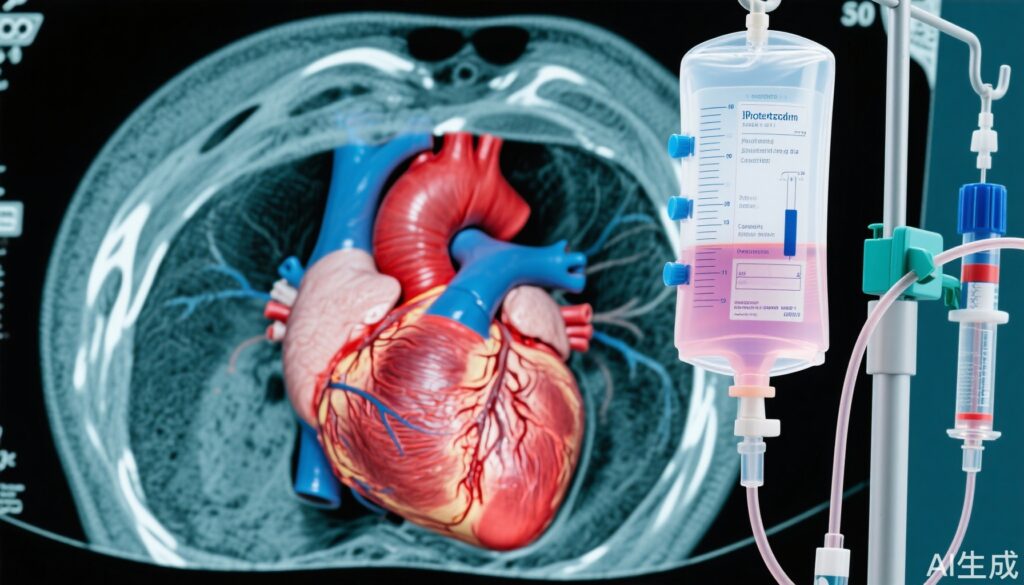Highlight
- The PRADA II trial investigated sacubitril-valsartan’s effect on preventing cardiac dysfunction induced by anthracycline-based breast cancer therapy.
- No statistically significant difference in left ventricular ejection fraction (LVEF) decline was observed between sacubitril-valsartan and placebo groups over 18 months.
- Left ventricular global longitudinal strain (GLS) was maintained with sacubitril-valsartan, contrasting with progressive decline in controls.
- Lower elevations of cardiac troponin I and NT-proBNP biomarkers were observed with sacubitril-valsartan, indicating reduced myocardial injury and stress.
Study Background and Disease Burden
Breast cancer is the most common malignancy among women globally, with anthracycline-containing chemotherapy remaining a cornerstone of adjuvant treatment protocols. Despite its efficacy, anthracycline use is limited by dose-dependent cardiotoxicity, presenting as myocardial injury and subsequent cardiac dysfunction. This cardiotoxicity increases the risk of heart failure and often necessitates dose reductions or discontinuation of potentially curative cancer therapy, thus impacting overall survival.
Trastuzumab, used for HER2-positive breast cancer, further compels the risk of cardiotoxicity. Current cardioprotective strategies are suboptimal.
Angiotensin receptor neprilysin inhibitors (ARNIs), notably sacubitril-valsartan, have demonstrated efficacy in treating heart failure with reduced ejection fraction by modulating neurohormonal pathways and enhancing natriuretic peptide action. However, their potential to prevent cancer therapy-related cardiac dysfunction remains unclear. The PRADA II trial sought to address this unmet clinical need by evaluating the prophylactic role of sacubitril-valsartan started concomitantly with anthracycline-based regimens.
Study Design
The PRADA II trial was a randomized, double-blind, placebo-controlled, parallel-group multicenter study conducted across four academic cardiovascular centers in Norway.
A total of 138 women with early breast cancer, eligible for anthracycline-containing chemotherapy, were randomized in a 1:1 ratio to receive either sacubitril-valsartan or matched placebo. The investigational drug was titrated to a target dose of 97/103 mg twice daily and administered concomitantly with cancer therapy and continued for 18 months.
The primary endpoint was the absolute change in left ventricular ejection fraction (LVEF), quantified using cardiovascular magnetic resonance (CMR) imaging, from baseline pre-chemotherapy to 18 months post-initiation.
Secondary endpoints included changes in echocardiographic global longitudinal strain (GLS), alterations in circulating cardiac biomarkers—cardiac troponin I and N-terminal pro-B-type natriuretic peptide (NT-proBNP)—and safety assessments.
Key Findings
Baseline characteristics were balanced between groups, with a mean age of 54 years.
Primary Outcome:
Over 18 months, the placebo group exhibited a mean decline in LVEF of 2.2 percentage points (95% CI, 1.1 to 3.3), whereas the sacubitril-valsartan group demonstrated a smaller, non-significant decline of 1.1 percentage points (95% CI, -0.01 to 2.2). The between-group difference of 1.1 percentage points was not statistically significant (95% CI, -0.4 to 2.7; P=0.16).
Secondary Outcomes:
The sacubitril-valsartan group maintained normal GLS values, with a negligible change from baseline (-0.32, 95% CI, -0.80 to 0.15). In contrast, the placebo group experienced a progressive decline in GLS (0.53, 95% CI, 0.05 to 1.00), indicating worsening subclinical myocardial function. The difference between groups was statistically significant (-0.85, 95% CI, -1.52 to -0.18), suggesting preserved myocardial deformation with sacubitril-valsartan.
Regarding cardiac biomarkers, both NT-proBNP and cardiac troponin I concentrations increased significantly more in the placebo group compared to the sacubitril-valsartan group. The log difference was 0.303 (95% CI, 0.0547 to 0.552) for NT-proBNP and 0.534 (95% CI, 0.114 to 0.954) for cardiac troponin I, consistent with greater myocardial injury and stress in the placebo arm.
Safety and Tolerability:
Sacubitril-valsartan was generally well tolerated. Adverse events were consistent with its known safety profile, with no new safety signals detected.
Expert Commentary
The PRADA II trial contributes important insights into the cardioprotective potential of sacubitril-valsartan during cardiotoxic chemotherapy. While this ARNI did not significantly prevent the modest LVEF decline observed, the preservation of GLS and attenuation of biomarker increase suggest that sacubitril-valsartan may mitigate subclinical cardiac injury.
GLS is recognized as a sensitive indicator of early myocardial dysfunction preceding overt LVEF changes. The positive GLS results align with biomarker data, reinforcing the notion of myocardial protection.
Several factors might explain the primary outcome findings, including the relatively small effect size of cardiotoxicity, sample size limitations, and the study population’s baseline cardiac health.
Notably, the absence of a significant LVEF preservation does not negate clinical benefit, as even small improvements in myocardial strain and injury markers could translate into improved long-term cardiac outcomes. Larger studies with longer follow-up are warranted to confirm these findings and elucidate clinical implications.
Current clinical guidelines emphasize careful cardiac monitoring during anthracycline and trastuzumab therapy but do not specifically recommend ARNI use for cardioprotection. The PRADA II data may inform future guideline updates if corroborated.
Conclusion
Anthracycline-based adjuvant breast cancer therapy is associated with modest but measurable declines in left ventricular systolic function. The PRADA II trial demonstrates that sacubitril-valsartan, administered concomitantly with chemotherapy over 18 months, did not significantly attenuate this LVEF reduction. However, sacubitril-valsartan favorably impacted sensitive measures of myocardial function and injury, including global longitudinal strain and cardiac biomarkers.
These findings suggest a potential role for sacubitril-valsartan in early cardioprotection during cancer therapy, emphasizing the need for further research to explore its long-term impact on cardiac outcomes and clinical practice.
Clinicians should continue rigorous cardiac monitoring for patients undergoing cardiotoxic chemotherapy and consider evolving evidence for cardioprotective strategies.
References
1. Omland T, Heck SL, Holte E, Mecinaj Lilleaasen A, Gynnild MN, Fagerland MW, Vinje-Jakobsen V, Næs AL, Blix ES, Larsen AI, Geisler J, Gulati G, Wethal T. Sacubitril-Valsartan and Prevention of Cardiac Dysfunction During Adjuvant Breast Cancer Therapy: The PRADA II Randomized Clinical Trial. Circulation. 2025 Aug 29. doi: 10.1161/CIRCULATIONAHA.125.076616. Epub ahead of print. PMID: 40884047.
2. Armenian SH, Lacchetti C, Barac A, Carver J, Constine LS, Denduluri N, et al. Prevention and Monitoring of Cardiac Dysfunction in Survivors of Adult Cancers: American Society of Clinical Oncology Clinical Practice Guideline. J Clin Oncol. 2017 Feb 10;35(8):893-911.
3. Lyon AR, Dent S, Stanway S, Earl H, Brezden-Masley C, Ashfield M, et al. Baseline cardiovascular risk assessment in cancer patients scheduled to receive cardiotoxic cancer therapies: a position statement and new risk assessment tools from the Cardio-Oncology Study Group of the Heart Failure Association of the European Society of Cardiology in collaboration with the International Cardio-Oncology Society. Eur J Heart Fail. 2020 Dec;22(12):1945-1960.



